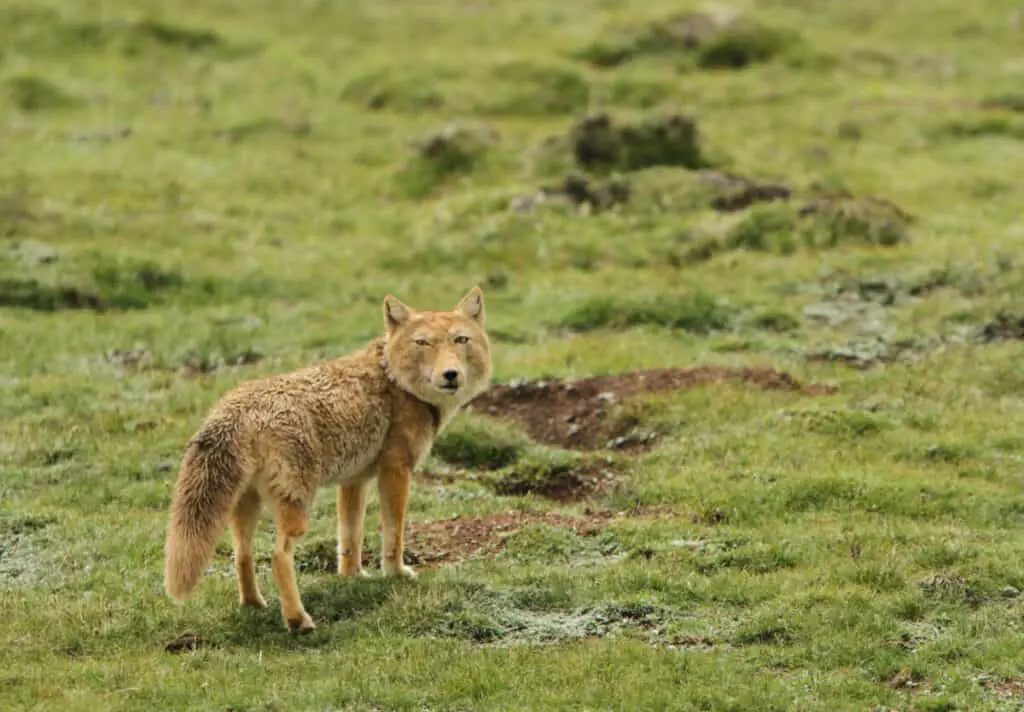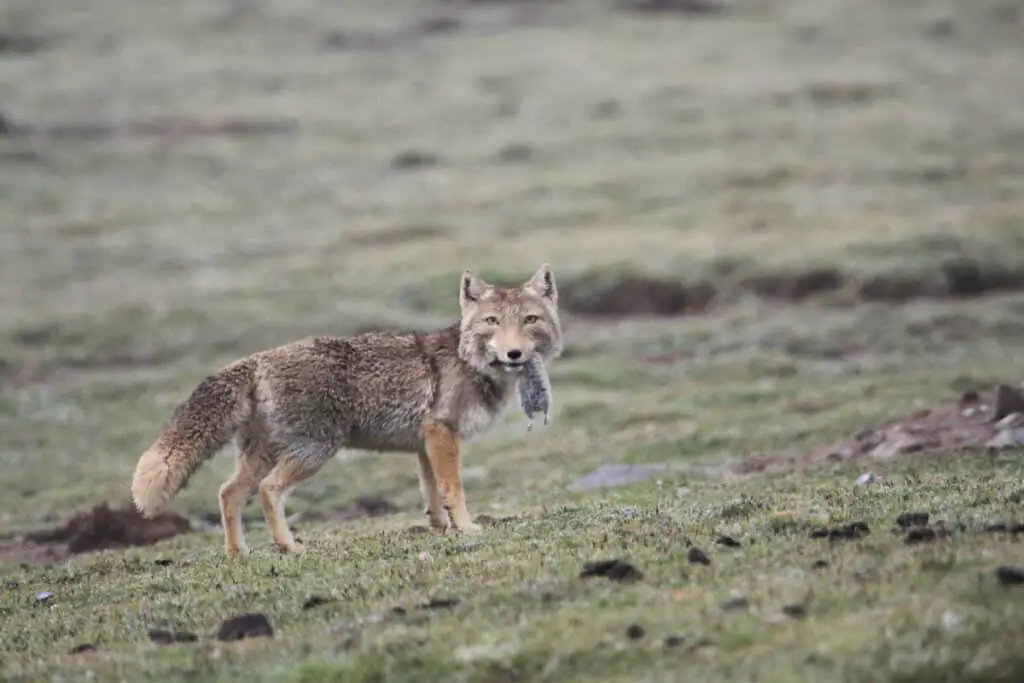The Tibetan fox is a small carnivore that is native to the high-altitude regions of Tibet and surrounding areas, and have adapted to survive in some of the harshest environments on Earth.
One notable feature of Tibetan foxes is their distinctive appearance. They have reddish-brown fur with white patches on their faces, chests, and bellies. Their tails are bushy and often tipped with black or white.
Despite being relatively small (usually weighing around 4-6kg), these animals are skilled hunters that can take down prey much larger than themselves.
In this article, we’ll explore more about the fascinating world of the Tibetan fox and what makes them such unique creatures.

Habitat And Range
The Tibetan fox, also known as the sand fox or the Ladakh fox, is a small-sized carnivore that inhabits the high-altitude regions of Central Asia. Their range stretches across Tibet, Nepal, Bhutan and parts of China.
These adaptable creatures are found in diverse habitats ranging from open plains to rocky outcrops and mountainous terrain.
Natural predators such as wolves, eagles, and snow leopards pose a threat to the Tibetan foxes. To avoid these threats, they have developed unique hunting techniques. They hunt primarily at dawn and dusk when visibility is low, allowing them to remain undetected by their prey and potential predators.
The Tibetan fox preys on small animals like rodents and hares but will also eat insects if necessary for survival. With its bushy tail and striking reddish-brown coat, it has adapted remarkably well to life in harsh environments where little else can survive.
Physical Characteristics
The Tibetan fox, also known as the sand fox, inhabits high-altitude regions in Tibet and other parts of Central Asia. These elusive creatures are found at altitudes ranging from 3,000 to 5,500 meters above sea level. Interestingly enough, these foxes have adapted to life on mountains by having a thicker coat than their lowland counterparts.
Moving on to physical characteristics, Tibetan foxes are small canids with distinctively narrow muzzles and bushy tails. They have reddish-brown fur that blends well with their surroundings during winter months when snow covers the ground. Additionally, they possess sharp teeth and claws that aid them in hunting prey such as pikas and rodents.
Behavioral traits include being solitary animals who only come together during breeding season which occurs between November and January. During this time males will fight over females for mating rights. Females give birth to litters of two to six pups in dens dug into the ground or under rocks. Breeding habits for female Tibetan foxes seem unique because they do not mate every year but instead wait until conditions are optimal for raising young successfully.
Diet And Hunting
The Tibetan fox is an opportunistic predator, meaning it will eat whatever prey is available to them. However, they do have some preferences when it comes to their diet. Their favorite food includes pikas, rodents found in high-altitude areas, and other small mammals like voles and hares. They also feed on birds, insects, and carrion.
To hunt for their prey, the Tibetan fox uses a variety of techniques depending on the availability of prey and their location. In open terrain, they use their keen sense of sight and hearing to stalk or chase down their prey. In rocky terrain where stalking may be difficult, they dig into burrows with lightning speeds to catch any unsuspecting prey inside.
The Tibetan fox has even been known to follow larger predators such as wolves or bears to scavenge off any leftover carcasses.
Social Behavior And Communication
It’s ironic how the Tibetan fox has a reputation for being solitary when, in fact, they engage in complex social behavior.
They live in family groups of up to 6 members and communicate with each other through body language and vocalizations.
Body language plays a crucial role in their communication. When greeting each other, they raise their tails high as a sign of respect.
On the other hand, if one is feeling threatened or aggressive, they will flatten their ears against their head and bare their teeth.
Vocalizations also play an important role in communicating with each other. They use barks, yips, and growls to express different emotions and intentions.
It’s fascinating how these seemingly simple sounds can convey so much meaning within their social group.
Conservation Status
The conservation status of the Tibetan fox is currently listed as ‘Least Concern’ by the International Union for Conservation of Nature. However, this does not mean that there are no threats to their population. Human activities such as hunting and habitat destruction pose significant risks to these animals.
Threats:
- Habitat loss due to mining and infrastructure development
- Hunting for fur and medicinal purposes
- Competition with domestic livestock for resources
Conservation efforts have been made to mitigate these threats. One such effort is through education and awareness campaigns aimed at reducing human-wildlife conflict. Additionally, protected areas have been established where the Tibetan fox can safely live without fear of being hunted or losing their homes to development.
Conservation Efforts:
- Education and awareness campaigns
- Establishment of protected areas
- Monitoring populations and enforcing protective laws – Rehabilitation and reintroduction programs for endangered species
While more work needs to be done in terms of monitoring populations and enforcing laws protecting them, current conservation efforts offer hope for the continued survival of this unique species.

Cultural Significance In Tibetan Mythology And Folklore
Despite the conservation status of the Tibetan fox, it is worth noting that this animal holds great significance in Tibetan mythology and folklore. In fact, it has been a prominent figure in many mythical beliefs and spiritual symbolism.
According to Tibetan legend, the Tibetan fox was often depicted as a cunning trickster who outsmarted its prey with its intelligence and wit. It was also believed to have supernatural powers such as shape-shifting abilities, which made it an important symbol of transformation and metamorphosis. Furthermore, the fur of the Tibetan fox was considered sacred among Tibetans and was used in various religious rituals as a symbol of protection against evil spirits.
Overall, these mythological beliefs showcase how deeply ingrained the Tibetan fox is within Tibetan culture and history.
The cultural significance of the Tibetan fox continues to be felt even today amongst modern-day Tibetans. For instance, some still believe that encountering a Tibetan fox is an omen of good luck or prosperity while others consider them to be guardians of their homes or villages.
Additionally, there are several festivals held throughout Tibet where people dress up in costumes resembling the iconic creature. These festivities serve not only as celebrations but also a way for current generations to connect with their rich cultural heritage through symbolic representation.
Ultimately, it can be said that despite being threatened by human activities such as hunting and habitat loss, the mystical aura surrounding the Tibetan fox will continue to live on for generations to come.
Conclusion
In conclusion, the Tibetan fox is a fascinating and unique creature that inhabits some of the world’s harshest environments. Its physical characteristics make it well adapted to life in these regions, where food can be scarce.
Despite its solitary nature, Tibetan foxes have complex social behaviors and communication methods that allow them to thrive.
As the old adage goes, ‘the more we know about other species, the more we understand ourselves.’ Learning about animals like the Tibetan fox helps us appreciate the diversity of life on Earth and reminds us of our interconnectedness with all living things.
It is important that we continue to study and protect these amazing creatures so that future generations can also enjoy their presence in the wild.

